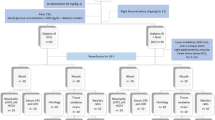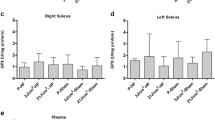Abstract
Low-level laser therapy has been shown to decrease ischemia–reperfusion injuries in the skeletal muscle by induction of synthesis of antioxidants and other cytoprotective proteins. Recently, the light-emitting diode (LED) has been used instead of laser for the treatment of various diseases because of its low operational cost compared to the use of a laser. The objective of this work was to analyze the effects of LED therapy at 904 nm on skeletal muscle ischemia–reperfusion injury in rats. Thirty healthy male Wistar rats were allocated into three groups of ten rats each as follows: normal (N), ischemia–reperfusion (IR), and ischemia–reperfusion + LED (IR + LED) therapy. Ischemia was induced by right femoral artery clipping for 2 h followed by 2 h of reperfusion. The IR + LED group received LED irradiation on the right gastrocnemius muscle (4 J/cm2) immediately and 1 h following blood supply occlusion for 10 min. At the end of trial, the animals were euthanized and the right gastrocnemius muscles were submitted to histological and histochemical analysis. The extent of muscle damage in the IR + LED group was significantly lower than that in the IR group (P < 0.05). In comparison with other groups, tissue malondialdehyde (MDA) levels in the IR group were significantly increased (P < 0.05). The muscle tissue glutathione (GSH), superoxide dismutases (SOD), and catalase (CAT) levels in the IR group were significantly lower than those in the subjects in other groups. From the histological and histochemical perspective, the LED therapy has alleviated the metabolic injuries in the skeletal muscle ischemia reperfusion in this experimental model.







Similar content being viewed by others
References
Takhtfooladi MA, Jahanshahi A, Sotoudeh A, Jahanshahi G, Aslani K, Khansari M, Adibi S, Takhtfooladi HA (2012) Effects of N-acetylcysteine upon the rat serum enzyme changes in skeletal muscle ischemia reperfusion. Ann Biol Res 3(8):4099–4102
Takhtfooladi MA, Jahanshahi A, Sotoudeh A et al (2012) Synergistic protective effect of ischemic preconditioning technique in combination of N-acetylcysteine on skeletal muscle ischemia reperfusion injury in rat; Histopathological study. Eur J Exp Biol 2(5):1766–1770
Takhtfooladi MA, Jahanshahi G, Sotoudeh A, Jahanshahi A (2013) Protective effects of N-acetylcysteine on myocardial injury induced by hindlimb ischaemia–reperfusion: a histological study in rat model. Comp Clin Pathol. doi:10.1007/s00580-013-1768-7
Takhtfooladi MA, Jahanshahi A, Sotoudeh A et al (2013) Effect of tramadol on lung injury induced by skeletal muscle ischemia-reperfusion: an experimental study. J Bras Pneumol 39(4):434–439
Takhtfooladi MA, Jahanshahi A, Sotoudeh A et al (2013) Neuroprotective effects of tramadol on cerebral injuries caused by hind limb ischaemia/reperfusion in rats. Comp Clin Pathol. doi:10.1007/s00580-013-1753-1
Takhtfooladi MA, Jahanshahi A, Jahanshahi GH, Sotoudeh A, Takhtfooladi HA, Khansari M (2012) Protective effect of N-acetylcysteine on kidney as a remote organ after skeletal muscle ischemia-reperfusion. Acta Cir Bras 27(9):611–615
Sotoudeh A, Takhtfooladi MA, Jahanshahi A, Khiabanian Asl AH, Takhtfooladi HA, Khansari M (2012) Effect of N-acetylcysteine on lung injury induced by skeletal muscle ischemia-reperfusion. Histopathological study in rat model. Acta Cir Bras 27(2):168–171
Takhtfooladi MA, Jahanshahi A, Sotoudeh A, Daneshi MH, Khansari M, Takhtfooladi HA (2013) The antioxidant role of N-acetylcysteine on the testicular remote injury after skeletal muscle ischemia and reperfusion in rats. Pol J Pathol 64(3):204–209. doi:10.5114/PJP.2013.38140
da Silveira M, Yoshida WB (2004) Ischemia and reperfusion in skeletal muscle injury mechanisms and treatment perspectives. J Vasc Br 3(4):367–378
Brunelli GA, Brunelli GR (1995) Tissue changes at different periods of ischemia. Int Angiol 14(3):253–263
Gordon L, Buncke HJ, Townsend JJ (1978) Histological changes in skeletal muscle after temporary independent occlusion of arterial and venous supply. Plast Reconstr Surg 61(4):576–579
Lagerwall K, Daneryd P, Schersten T, Soussi B (1995) In vivo 31P nuclear magnetic resonance evidence of the salvage effect of ascorbate on the postischemic reperfused rat skeletal muscle. Life Sci 56(6):389–397
Skjeldal S, Grogaard B, Reikeras O, Muller C, Torvik A, Svindland A (1991) Model for skeletal muscle ischemia in rat hindlimb: evaluation of reperfusion and necrosis. Eur Surg Res 23(5–6):355–365
Lindsay TF, Liauw S, Romaschin AD, Walker PM (1990) The effect of ischemia/reperfusion on adenine nucleotide metabolism and xanthine oxidase production in skeletal muscle. J Vasc Surg 12(1):8–15
Labbe R, Lindsay T, Walker PM (1987) The extent and distribution of skeletal muscle necrosis after graded periods of complete ischemia. J Vasc Surg 6(2):152–157
Eells JT, Wong-Riley MT, VerHoeve J, Henry M, Buchman EV, Kane MP, Gould LJ, Das R, Jett M, Hodgson BD, Margolis D, Whelan HT (2004) Mitochondrial signal transduction in accelerated wound and retinal healing by near-infrared light therapy. Mitochondrion 4(5–6):559–567. doi:10.1016/j.mito.2004.07.033
Douris P, Southard V, Ferrigi R, Grauer J, Katz D, Nascimento C, Podbielski P (2006) Effect of phototherapy on delayed onset muscle soreness. Photomed Laser Surg 24(3):377–382. doi:10.1089/pho.2006.24.377
Komine N, Ikeda K, Tada K, Hashimoto N, Sugimoto N, Tomita K (2010) Activation of the extracellular signal-regulated kinase signal pathway by light emitting diode irradiation. Lasers Med Sci 25(4):531–537. doi:10.1007/s10103-009-0743-7
Wong-Riley MT, Liang HL, Eells JT, Chance B, Henry MM, Buchmann E, Kane M, Whelan HT (2005) Photobiomodulation directly benefits primary neurons functionally inactivated by toxins: role of cytochrome c oxidase. J Biol Chem 280(6):4761–4771. doi:10.1074/jbc.M409650200
Liang HL, Whelan HT, Eells JT, Wong-Riley MT (2008) Near-infrared light via light-emitting diode treatment is therapeutic against rotenone- and 1-methyl-4-phenylpyridinium ion-induced neurotoxicity. Neuroscience 153(4):963–974. doi:10.1016/j. neuroscience.2008.03.042
Whelan HT, Buchmann EV, Dhokalia A, Kane MP, Whelan NT, Wong-Riley MT, Eells JT, Gould LJ, Hammamieh R, Das R, Jett M (2003) Effect of NASA light-emitting diode irradiation on molecular changes for wound healing in diabetic mice. J Clin Laser Med Surg 21(2):67–74. doi:10.1089/104454703765035484
Vinck EM, Cagnie BJ, Cornelissen MJ, Declercq HA, Cambier DC (2003) Increased fibroblast proliferation induced by light emitting diode and low power laser irradiation. Lasers Med Sci 18(2):95–99. doi:10.1007/s10103-003-0262-x
Xavier M, David DR, de Souza RA, Arrieiro AN, Miranda H, Santana ET, Silva JA Jr, Salgado MA, Aimbire F, Albertini R (2010) Anti-inflammatory effects of low-level light emitting diode therapy on Achilles tendinitis in rats. Lasers Surg Med 42(6):553–558. doi:10.1002/lsm.20896
Lim W, Lee S, Kim I, Chung M, Kim M, Lim H, Park J, Kim O, Choi H (2007) The anti-inflammatory mechanism of 635-nm light-emitting-diode irradiation compared with existing COX inhibitors. Lasers Surg Med 39(7):614–621. doi:10.1002/lsm.20533
Casalechi HL, Nicolau RA, Casalechi VL, Silveira L Jr, De Paula AM, Pacheco MT (2009) The effects of low-level light emitting diode on the repair process of Achilles tendon therapy in rats. Lasers Med Sci 24(4):659–665. doi:10.1007/s10103-008-0607-6
Karu TI, Pyatibrat LV, Kalendo GS (2001) Cell attachment modulation by radiation from a pulsed light diode (lambda0820 nm) and various chemicals. Lasers Surg Med 28(3):227–236. doi:10.1002/lsm.1043
Sussai DA, Carvalho Pde T, Dourado DM, Belchior AC, dos Reis FA, Pereira DM (2010) Low-level laser therapy attenuates creatine kinase levels and apoptosis during forced swimming in rats. Lasers Med Sci 25(1):115–120. doi:10.1007/s10103-009-0697-9
da Costa Santos VB, de Paula Ramos S, Milanez VF, Corrêa JC, de Andrade Alves RI, Dias IF, Nakamura FY (2014) LED therapy or cryotherapy between exercise intervals in Wistar rats: anti-inflammatory and ergogenic effects. Lasers Med Sci 29(2):599–605. doi:10.1007/s10103-013-1371-9
Camargo MZ, Siqueira CP, Preti MC, Nakamura FY, de Lima FM, Dias IF, Toginho Filho Dde O, Ramos Sde P (2012) Effects of light emitting diode (LED) therapy and cold water immersion therapy on exercise-induced muscle damage in rats. Lasers Med Sci 27(5):1051–1058. doi:10.1007/s10103-011-1039-2
Ulrich R, Roeder G, Lorber C et al (2001) Continuous venovenous hemofiltration improves arterial oxygenation in endotoxin-induced lung injury in pigs. Anesthesiology 95(2):428
Boyne AF, Ellman GL (1972) A methodology for analysis of tissue sulfhydryl components. Anal Biochem 46:639
Sun Y, Oberley LW, Li Y (1988) A simple method for clinical assay of superoxide dismutase. Clin Chem 34:497
Aebi H (1974) Catalase. In: Bergmeyer U (ed) Methods of enzymatic analysis. Academic, New York, pp 673–677
Beuge JA, Aust SD (1978) Microsomal lipid peroxidation. Methods Enzymol 52:302
Perry MO (1988) Compartment syndromes and reperfusion injury. Surg Clin N Am 68:853–864
Quinones BWJ, Saleh S (1991) Acute arterial occlusion. In: Moore WS (ed) Vascular surgery. A comprehensive review, vol 33. Saunders, Philadelphia, pp 578–597
Morin D, Hauet T, Spedding M, Tillement J (2001) Mitochondria as target for antiischemic drugs. Adv Drug Deliv Rev 49:151–174
Barie PS, Mullins RJ (1988) Experimental methods in the pathogenesis of limb ischemia. J Surg Res 44:284–307
Swartz WM, Cha CJ, Clowes GH Jr, Randall HT (1978) The effect prolonged ischemia on high energy phosphate metabolism in skeletal muscle. Surg Ginecol Obstet 147:872–876
Yoshida WB (1996) Radicais livres na síndrome da isquemia e reperfusão. Cir Vasc e Angiol 12:82–95
Brooks B (1922) Pathologic changes in muscle as a result of disturbances of circulation: an experimental study of Volkmann’s ischemic paralysis. Arch Surg 5:188–216
Jimbo K, Noda K, Suzuki K, Yoda K (1998) Suppressive effects of low-power laser irradiation on bradykinin evoked action potentials in cultured murine dorsal root ganglion cells. Neurosci Lett 240(2):93–96
Simunovic Z, Trobonjaca T, Trobonjaca Z (1998) Treatment of medial and lateral epicondylitis—tennis and golfer’s elbow—with low level laser therapy: a multicenter double blind, placebo-controlled clinical study on 324 patients. J Clin Laser Med Surg 16(3):145–151
Serafim KG, Ramos SD, de Lima FM, Carandina M, Ferrari O, Dias IF, Toginho Filho DD, Siqueira CP (2011) Effects of 940 nm light-emitting diode (led) on sciatic nerve regeneration in rats. Lasers Med Sci. doi:10.1007/s10103-011-0923-0
Author information
Authors and Affiliations
Corresponding author
Rights and permissions
About this article
Cite this article
Takhtfooladi, M.A., Shahzamani, M., Takhtfooladi, H.A. et al. Effects of light-emitting diode (LED) therapy on skeletal muscle ischemia reperfusion in rats. Lasers Med Sci 30, 311–316 (2015). https://doi.org/10.1007/s10103-014-1670-9
Received:
Accepted:
Published:
Issue Date:
DOI: https://doi.org/10.1007/s10103-014-1670-9




